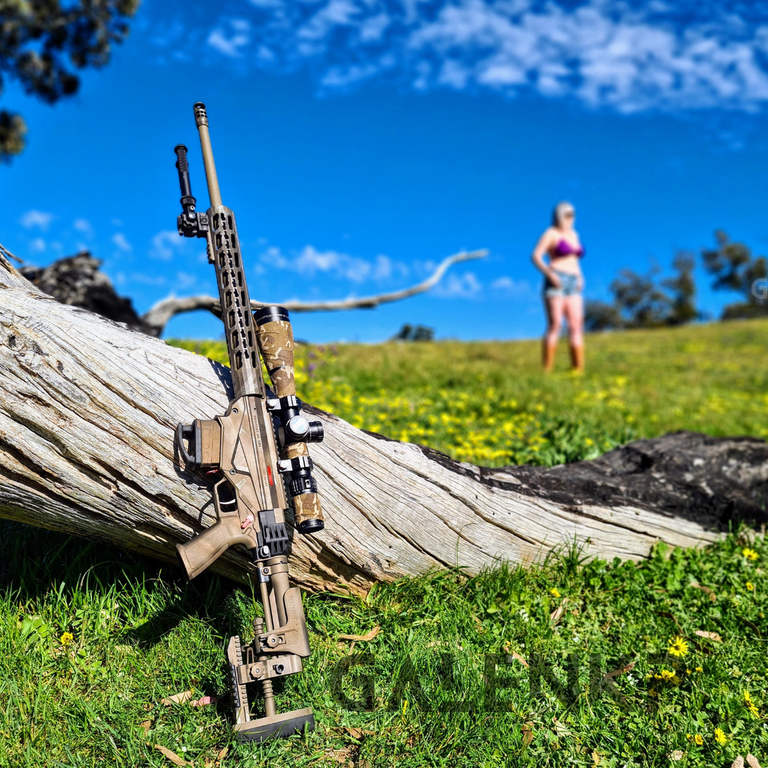
If you were at my front door you'd accurately determine how far the door was from you right? Let's say one metre. If you were looking at my house from several hundred of metres away would you be able to judge the distance that accurately, to within a metre? No, probably not.
I'm a long-range rifle shooter and can make accurate and repeatable shots at well over a mile; I never disclose my true limit, but it's a long way out there. Many things come into play to make shots like that, most of which I've written about previously, but one of the most fundamental is knowing exactly how far away the target is. Without that knowledge, to within a metre or so, shots miss - Not acceptable.
The easy way - Laser tech
I've used laser rangefinders a lot; This technology shoots a laser onto the target which returns to the device giving an incredibly accurate range-reading, to the metre, very quickly.
The range is then combined with a lot of other information to determine a field firing solution (FFS), meaning the amount of elevation and windage to input into the scope to make the shot.
Temperature, altitude and humidity combined as Density Altitude, wind speed and direction, azimuth, spin drift, Coriolis effect, muzzle velocity, the speed and direction of the target (if moving), projectile specifications, aerodynamic jump and other elements all combine to make a long-range shot possible, and knowing the range to the target is also vital.
On a firing range, distances are known, marked with flags or range-markers in intervals, but in the field the shooter must obtain the range to target for himself/herself; with laser technology that is easy enough.
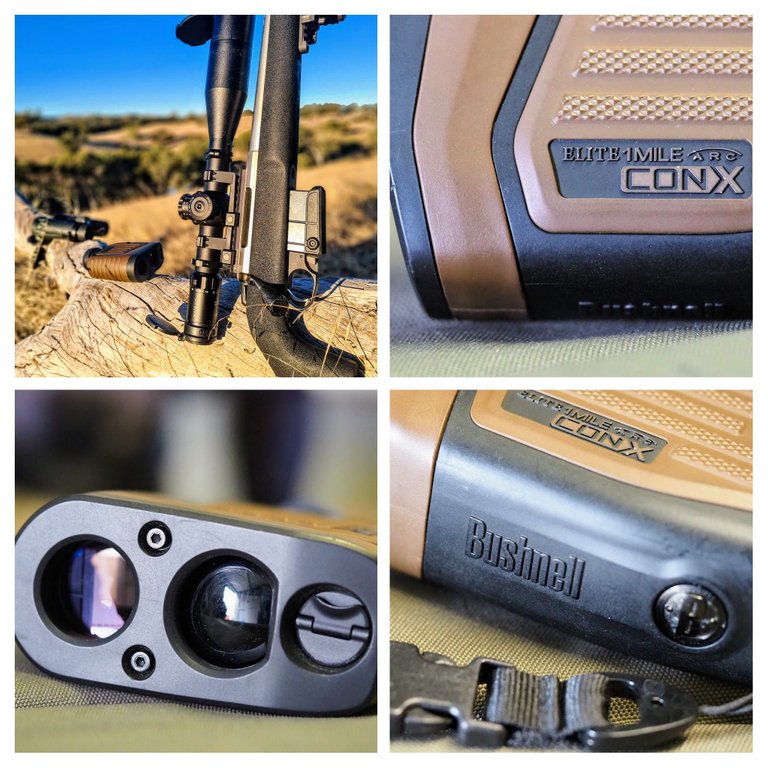
I currently use the Bushnell Elite 1 Mile CONX which ranges out to one mile (1609 metres) with relative ease.
I've used much better equipment, Vectronix rangefinders, used by the military; they're generally cost preventative though and most of the really good ones are government-regulated meaning restricted to military applications, anyway. Some have a range of twenty five kilometres and more and are used to range targets for missile and artillery strikes and other such devastating purposes like long range shooting, none of which a civilian would need...unless they're a terrorist I guess...hence why they're regulated here.
The one I use is awesome though, works very accurately and suits my needs, and at $1,200 AUD was affordable enough. But what happens if it breaks or the battery goes flat in the field?
A less techy solution
I can range-find with the naked eye. I practised by looking at things in the distance, guesstimating the range then range-finding them with laser equipment to see how accurate I was. I'm reasonably good at it, but sucked at first - Practice makes better though.
This only works out to fairly close ranges though, a couple hundred metres, and is not one-metre-accurate; at greater distances accuracy is much-reduced. With long range shooting, small margins of error mean failure to impact one's target and a lower hit-probability and that's never a good thing.
But there is a way to do it with almost perfect accuracy using just the rifle scope...and one's eyes, some geometry and mathematics.
But first, some information on milliradians for perspective.
Mil-whatians?
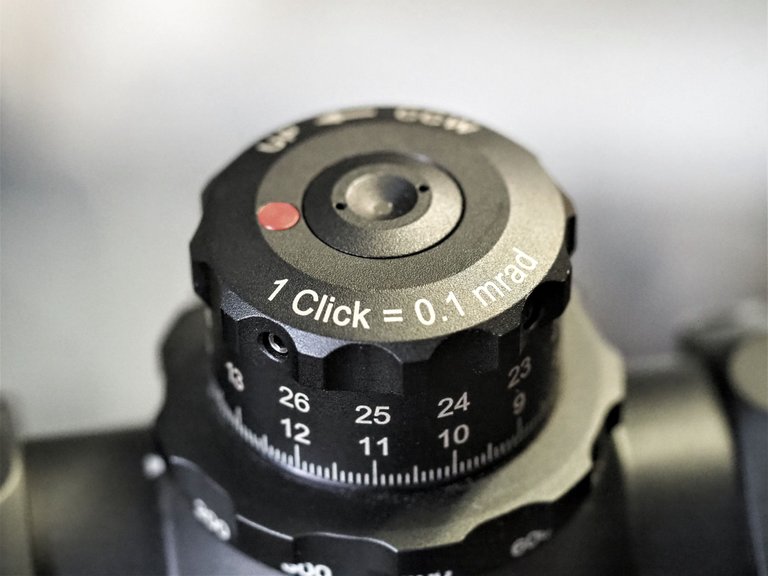
Milliradians [MRAD] (Sorry this part is kind of technical)
My scopes all have reticles with hash-marks in Milliradian (MRAD). MRAD is an angular measurement of part of a circle and, when applied to a reticle, allow the shooter to get better results from the rifle scope, shoot more accurately and to greater distances with a greater hit-probability and repeatability. There's other measurements used for the same thing, MOA for instance, but I use MRAD.
But what the hell is it?
Imagine a round pizza (or simply a circle as below) cut into six even slices with each beginning in the centre. The distance around the outer arc (crust) of one of those slices represents one radian.
To explain...The circumference of the entire pizza (circle) is two times Pi times the radius right? As we all know, Pi is 3.14159265 with some more numbers on the end, but let's say 3.14 ok? That means the entire circle of pizza is 6.28 radians...so, the outer edge (crust arc) of each of the six equal slices will be about one radian, as depicted in red below.
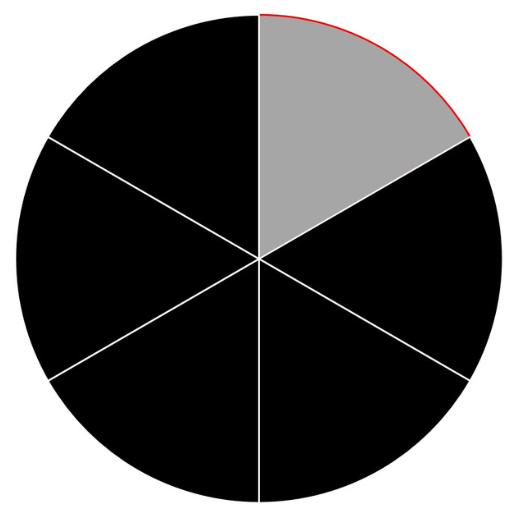
That's not so hard right?
Imagine just a single slice now - the grey one above - there's the pointy end and the outer arc in red right? Got that image? Just remember that that's one radian.
Now, imagine we cut that single slice (the one radian) into one thousand perfectly equal slices from the centre-point to the outer arc...now we have milliradians. See how easy it is? One thousand milliradians all side by side within the radian, like one thousand very thin slices within the slice.
Imagine that single pizza slice with the thousand milliradians in it again...now imagine it is one thousand yards in size from the pointy end to outer arc...the crust. Got that?
Now imagine the one thousand slices we cut it into again...The outer edge (crust) at 1000 yards from the centre-point will be precisely 36 inches (a yard) wide at the outer arc edge (the crust part) which means we now understand and accept that a milliradian at one thousand yards is equal to 36 inches (one yard). That means at one hundred yards, for instance, it's a tenth of that, so 3.6 inches.
The further out towards the crust of the pizza slice we go, the wider it becomes because the diverging lines - the angle. MRAD is a simple angular measurement.
Because I can't insert a thousand milliradians into the slice below I've just used the arrow to depict one milliradian, of course, the arrow is not true to the angle as it's not made of diverging lines. You get the idea though I guess.
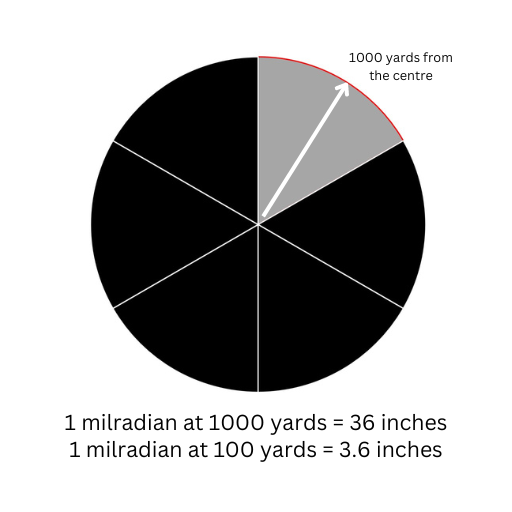
Anyway, that's milliradians in a nutshell just to set a basic understanding of the measurement and how it works. I went through all that above so that we all understand that angles are distance-proportional and because proportional relationships can assist us in determining the range of a target as I'll demonstrate below.
How it works in the field
Before we bring it all together we need a little more information and that can come in many different ways.
The whole concept of gaining a range using the scope and milliradians relies upon understanding the height of something downrange and applying a simple formula using that information. Let me explain.
Bad guys don't broadcast their height measurements, right? So we need some other reference which can be any known height downrange where the target is. Stay with me, it'll all make sense soon.
The front door to a house for instance...they're generally standard heights. An army tank track or turret height, roof-height of cars, road signs, 44 gallon water/fuel drums, jerry cans, an AK-47 leaning on a wall, RPG-7 (rocket propelled grenade launcher), a Humvee, Bushmaster, Land Rover, market stall roof, power pole, fence post, telephone or postal box...all have reasonably standard heights when found in the same area of operations and, if known, can be used to get a range using a simple formula...and all because we know that...at one thousand yards a milliradian is precisely 36 inches; it's proportional mathematics.
You'll not go wandering about measuring things, you'd look like an idiot; but long-range shooters will, and do, as it could be critical information if and when their laser rangefinder breaks down. Most of the information is available without having to wander about in hostile territory through studying data on previous engagements (DOPE), but a decent long-range shooter will verify data where possible; accurate shots may depend on it.
Now, lets get to the exciting bit; the formula.
Mil-ranging
Looking through the scope shows the shooter the reticle, see the example below taken from my ballistics solver, StrelokPro. There are many different reticles, the one you see below is the SKMR3 reticle in my Kahles k624i 6-24x56 rifle scope.
You'll notice those little black hash-markings - just ignore the red numbers ok? Those black hash-marks are used to make shots and also can be used to range a target. They measure in milliradians. This scope is also a first focal-plane scope meaning when I add or take away magnification the markings still measure 1:1 in MRAD (consistent subtension).
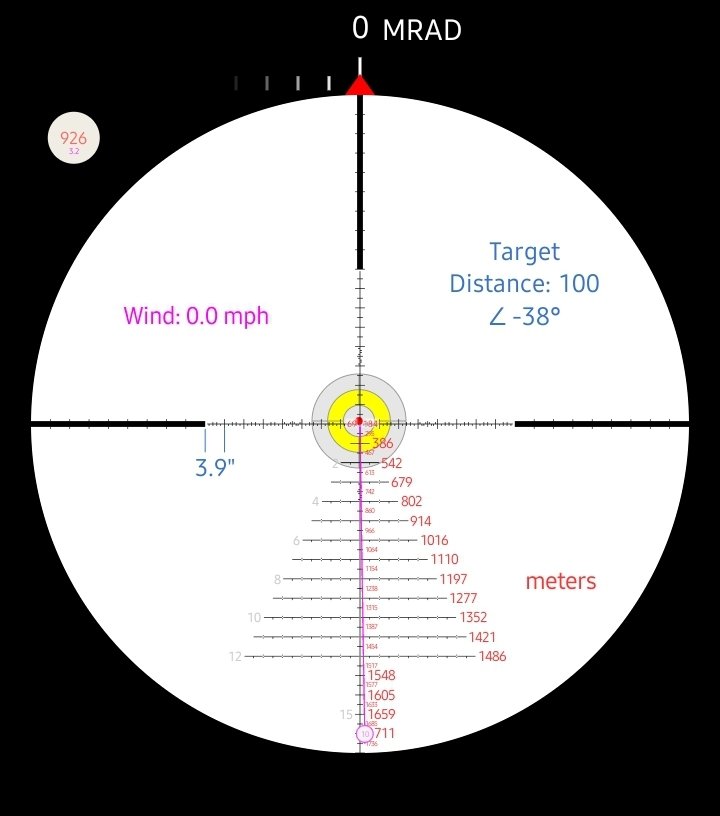
So now you know what the reticle looks like, here's the magic, but very simple, formula that allows me to range a target without a laser rangefinder. It's pretty simple if the height of something near the target is known.
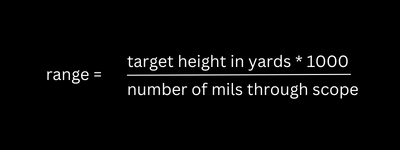
Here's what we know, if I placed a thirty six inch tall (one yard high) garden gnome at one thousand yards it will measure in the scope as one mil on the reticle. We know that because...one milliradian at 1000 yards measures precisely 36 inches (one yard) remember? Don't worry, the garden gnome is safe...but let's consider a real world situation, a terrorist down range.
Let's say the fellow is laying next to a Humvee which, we all know, has a roof-height of two yards (72 inches) - You can look that up if you like. I measure up the Humvee, ground to roof, through my scope and see it measures four mils tall in the scope. Great, now I have something to work with.
Applying the mil-ranging formula as below gives me a range of 500 yards (457.2 metres) to the target.
What I've done is use the known height of the Humvee roof, two yards/72 inches, to work into the formula because the chap is laying next to the Humvee - How tall he actually is doesn't matter at all, I know the range now, input the correct elevation adjustment to the scope and aim for the cross-hairs and...shoot.
Below the black up-down arrow shows 4 mil measured on the scope and I've added the Humvee Used as the known height.
72 inches (represented as 2 yards)* 1000/4 = 500.
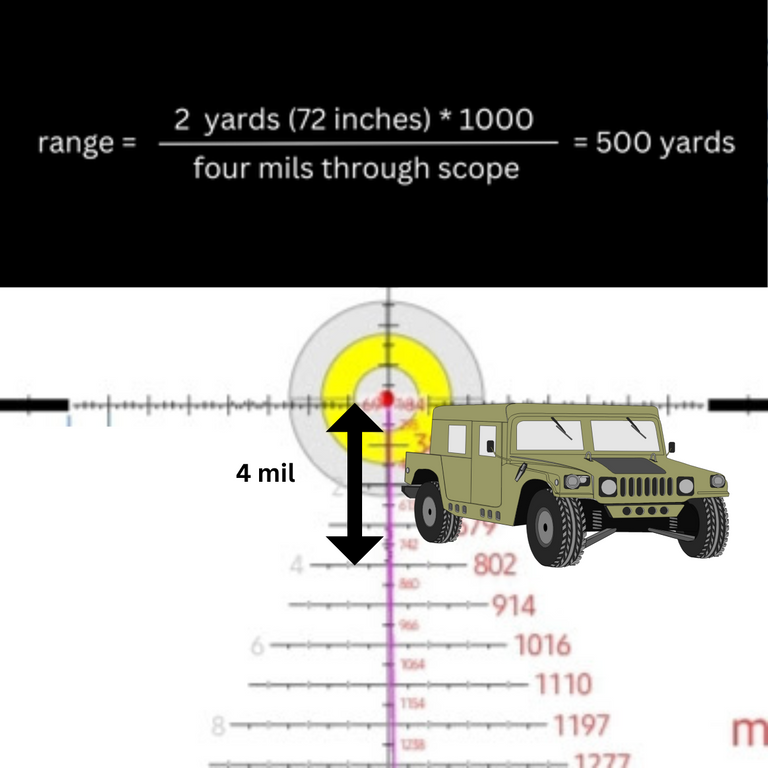
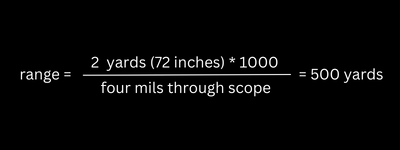
You can see how knowing the height of things around the area of operation is vitally important to figuring out the target range and once that is known a field firing solution (FFS) can be created and the shot taken with confidence. How often is this technique actually used? Preference is given to laser rangefinders these days of course, but this method has been used and will be again when needed.
I love the technology of laser rangefinders and ballistics calculators (StrelokPro for instance) and how they simplify a shooters process of shooting at long-range, but I'm a prepared man and not having a back-up method isn't my way. I need to know how to do what I do without the reliance on tech and whilst it might not happen as efficiently, the outcomes are usually the same.
This is a very basic explanation of some of the concepts around obtaining a target's range using a reticle, the eye, some geometry and math. I've kept it straightforward and simple and explained things in terms anyone could understand I think.
So many people think shooters are idiots who pop pumpkins in the back yard whilst swilling beer and, sure that probably happens, but not in my world; I'm a serious shooter, have serious skills and, whilst I depict myself as a nutbag and knucklehead most times, am neither. A lot goes into shooting at long-range effectively, safely, with high hit-probability and with repeated results and it's concepts like above that all come together to make it happen. I've spent thousands of hours in the field and classroom learning my craft and many countless more keeping those skills sharp.
That's it folks. If you have any questions feel free to ask in the comments and I'll answer as best I can.
Design and create your ideal life, don't live it by default; tomorrow isn't promised so be humble and kind - galenkp
[All original and proudly AI free.]
Any images in this post are my own. Main image is one of my ling-range rifles.
Great post. I love shooting, but hate math. With all my time in the field, I can fairly accurately guesstimate range out to 600 yards usually within a couple yards reliably, but beyond that not as much.
I've seen this and even some scopes like ATN versions take an average deer body size, hog size, etc. and use it to make distance estimates. I had an old bushnell laser rangefinder that was only good out to about 200 yards that I upgraded to a Sig Kilo2400BDX a couple years ago (good to 3,400 yards reflective, deer up to 1,400 yards). It's farther than I've ever shot, but I really love that thing.
My biggest takeaway is that I need to invest and carry a second laser rangefinder, cause I hate math, and because "two is one and one is none", lol. Seriously this is a good manual skill for those in combat situations for sure or even to practice and develop a cheat sheet, like a deer body is this many MRADs at this distance, a Coyote this many at that distance and this distance, etc.
Thanks mate, the hardest part of this post was delivering the information in an understandable way, meaning I know what I know, but explaining it properly is maybe beyond my skill.
Knowing range at greater distances is critical, although a guestimate can work and there's techniques designed around that like bracketing. But there's nothing like a good accurate rangefinder and the Sig one you have is great.
You're right on the cheat sheet (DOPE) and long range shooters will always gather it, record it and pass it along.
I'd not want to get caught out without a rangefinder, but it happens, and when operations need to continue unabated this mil-ranging formula and process works flawlessly.
Thanks for your comments and yep, as always: One is none and two is one.
All good operators know this. 😉
This was a cool post here dude. One thing I’m trying to figure out is how you figure out where to point the center of the scope. If the dude was laying on the ground under that passenger side tire that’s where you’d point the center dot, to get the shot? That ones a bit of a struggle but I think that’s what it sounds like, maybe. Likely more to that as it’s just focusing on vertical never mind horizontal.
The scopes have vertical adjustments as well as horizontal I’m sure, looking at the picture there. There’s a little knob for each like the outer knob does the vertical and inner knob horizontal I think.
I’m looking forward to getting my hands on a little rifle so I can figure these things out! I don’t look forward to the cost of the range finder though hahah but it’s part of the necessity I think!
Scopes have elevation (top turret) and windage (side turret). Both are required as one must dial in adjustments for both usually. (Range and wind conditions)
The range and adjustment is determined first, lets say I'm shooting at 5oo metres with a 3mph wind from 8 o'clock (-120°) which I have determined by observation and skill built up over a lot of training and field-work.
As per the chart I created on my ballistics solver for you...that's 1.7mil up and 0.2 mil left (to account for the wind coming from that direction as mentioned. (Keep in mind this varies depending on rifle, calibre and so on.)
So, two clicks left on windage and 17 clicks up on elevation. (As per this post and the image of the turret, 1 click = .01 MRAD)
It moves the reticle (basically) so I'd shoot directly for the centre of the cross-hairs. Make sense?
Both horizontal and vertical planes are critical. A miss high or low or a miss left or right is still a miss.
There is another way called, hold-over.
In this case, I don't dial in the adjustments, but use the hash-marks, the same 1.7U and 0.2L, and shoot for that point on the reticle rather than the centre of the cross hairs. That's used for very quick shooting when the time to dial in doesn't exist. At long range, say 500m+, most would dial in.
So...in the case of that terrorist beside the Humvee...I'd dial it in if I had time and aim for his head because he's laying down and that's likely all I'd see. At 500 metres it's an easy shot. At 1500 metres no so easy. In the latter case, I'd look for centre-mass meaning the largest thing I could aim for to make the shot count. Make sense?
Feel free to ask questions.
I can imagine that, I can even make it happen, but the rest you're writing about here is all Chinese to me 😂. I've read about this in a novel, but it was a novel and things were not described in such details, let alone graphics and formulas.
Anyway, it's nice to see a technical post like this on Hive, from someone who knows what he's talking about.
When I imagine pizza I get hungry for one and have to make or buy one to sate that hunger...Although, I didn't get one whilst writing this post for some reason. Wacky huh?
Yeah, it's all Chinese to most, just like knitting terminology is to me I guess, but I felt it might be good to share it as someone may be interested. I enjoyed the process of trying to explain it in words and writing the post in general, so that's all that matters.
You didn't get hungry while writing the post because you were focusing on the topic. Who can't really focus on it, gets hungry 😀.
Lol...But all the time is pizza time, that's a well known fact...like the hight of a Humvee roof.
Ok, I can accept that.
Fair warning ⚠️! Please make sure you check my next post only after you had a meal, or two 😂😂🤣
Warning acknowledged.
I have heard from expert snipers that they actually make these calculations every time they need to take long-range shots, like those ones on YouTube, but we never really see much of how it's done represented in movies. One would think it just takes a good eye to make the great shots, but I am stunned to kow that this much happens behind every shot.
It's so cool that you have this technique as back up because, really, anything could cause you to be unable to use the rangefinder. And if that happen, you would just be rendered ineffective with your shots. That's definitely something you wouln't want.
What I wonder, though, is how you came about become so great with the sniper rifle. I know it came with practice and study, but how did it start for you? Were you in the military or something?
I didn't know that you know expert snipers.
A good eye is required to shoot anything, including at long -range, although a good eye by itself is never going to be enough, as you can see a lot goes into it. Also, forget what you see on movies, it's all rubbish made for entertainment purposes.
A decent long-range shooter is rarely totally ineffective as there's other ways to make shots count, data on previous engagements (DOPE) is one way, and if a shooter was operating in an area for a while would have the area ranged out fairly well from paper maps or GPS positioning; it's called preparation. There's more than one way to ensure rounds on targets and mil-ranging is just one of them.
Thanks for your comments.
Well yeah, actually. Filmmakers tend to exaggerate or over-simplify things in flms. I probably would be too nerdy to have the actual shooting process described in films. MRAD, range, circumference, you know... People would skip...
Yeah, people don't want to use their brains these days, preferring to get their information downloaded to them in the form of propaganda, and their thinking done for them.
Man that is some serious skill right there! I have shot a lot of paper with everything from pistols to rifles and, to be honest, popping pumpkins and chugging beer sounds like my idea of a good time!
Jokes aside, some of the people I have shot with have serious talent in long range shooting. Such a fantastic skill to enjoy and become good at. I believe everyone should have some sort of hobby shooting experience as it does build respect for firearms and the people who collect and follow the rules with them.
Those who develop a skill like yours are on another level, or are maybe Swiss. ;).
In-depth and informative again old friend!
Guns, pumpkins and beer, what could ever go wrong?
I'm not Swiss, but I found an affinity with long-range shooting. I liked the way so many factors have to come together and then all rely upon breathing, and the movement of one single finger, to complete. I make my own ammunition, precision loads, these days but back in the day used match-grade ammunition...adding that element in is another interesting (to me) part of shooting at long range. Developing the load, testing it to find the right one for the rifle, is a fascinating process but critical to accuracy and repeatability.
All together I find the entire process enjoyable. (Frustrating at times also.)
And...a pumpkin or three have been punished...despite me not being much of a drinker.
Fascinating! Are you shooting for military purposes or by your own passion?
I loved the TV Serie "Sniper", where a pro-sniper from USA was framed in a murder but he manages to set himself free. It lasts three seasons and it was really addictive!
I hard about that TV show. I have trouble watching shows and movies with shooting in them sometimes as they often get many many things wrong. Sometimes it's funny, but it also misrepresents shooting and shooters and helps people form incorrect or invalid opinions. I guess it happens with other things also, movies and TV shows are just entertainment, not educational information, some can't make the distinction though.
Thanks for your comment.
I am sure they just make entertainment and they share many things wrong or superficially. But it was nice, especially from the pshycological perspective.
Best luck for your shooting path!
I sometimes like watching those shows for a laugh and occasionally they surprise me, in that they get a lot of things right; that's rare though.
In my youth, I liked to shoot, and I shot well. My father taught me when I was a child. And I love math! LOL. I think I could not give a better and clearer explanation.
Unfortunately, due to work (and age, I guess) my vision has deteriorated a lot, and once I could see 120%. It's a shame not being able to aim well if I see the occupier with my own eyes.
I read your post with great pleasure. You are too hard on yourself. Your illustrations are quite good and you are a very good storyteller. My respect!
Good vision is required to shoot well, at close range or long range as small margins of error will more often than not result in a miss downrange. Most shooters only operate at ranges out to 300 meters, hunters etc. as beyond that (generally) specialist equipment is needed. No matter how good the equipment is though, without good eyesight a shooting accurately isn't possible.
Maybe with the right pair of glasses you could shoot again?
Thanks for your comment.
I put on glasses when reading or using the computer. But how to shoot in glasses?😒
I have shot guns wearing glasses for over thirty years.
Are you serious? I think I should try it again. No, I mean it. Thanks!
!BEER
I wear Oakley wrap-around glasses when shooting, always have...as have almost every person I've ever shot with; eye protection is always a good idea. In the last several years those glasses have been prescription. I also use my general prescription glasses when I shoot at night as the Oakley's are too dark.
But can such glasses provide both protection and ... dioptres?
View or trade
BEER.BEERHey @galenkp, here is a little bit of from @zirochka for you. Enjoy it!BEER at dCity game to buy cards to rule the world.Did you know that <a href='https://dcity.io/cityyou can use
Lots of good stuff here, thanks! I grabbed a range finder to begin this process, but it turned out to be a split image type intended for golf. Education takes many forms, LOL; I will try again....
I enjoyed your post, already had the milirads down from engineering calculations, but this is a practical use for ranging, thanks! The hummer was obviously not through a scope, but it does illustrate my question. Does the angle cause much distortion? Measuring front to back will give different results ( I know this is grossly distorted for a 500 yard scope hummer picture) but do you need to estimate center for best results?
Second question ( sorry, I know this is basic for you) with a laser range finder, does angle on the painted surface reduce the accuracy by bouncing the primary return off at an angle? I know it will reduce the needed return signal level.
As always you make me think!
👍💗🤠😴
The golf ones don't do the job, as you found out.
Angle will make a difference to the measurement but it's not generally great enough to cause a miss. With the calibres being used almost any impact will cause a problem for the target. Center mass is the way to go and if the range is off slightly it'll still hit something soft. You know?
This is a good question. Yes is probably the answer, but again, probably not greatly enough to affect the overall shot. When I range out culling I'm lasing fury animals which are non reflective and if the range is off a little it rarely makes a difference. I'd say it's no factor, minimal enough to not affect the end result significantly.
That's about what I thought, and they lied to me on the range finder. It was listed for long range shooting! Tossed it to not learn bad habits. May put it on my laser bench to play with for beam splitting, we'll see how tuff it really is!
I haven't been posting here, because a buildawhale bot has been downvoting me for posting on the homeless meal last month. Apparently he preserves his hive value, by heavy random downvoters to reduce other accounts crypto. He hasn't posted in years, so he's a cancer left over from steemit.
With my wife still in the hospital, I just stopped hive posts; to avoid cyber bullying!
I bought a large (12 kw) dual fuel generator for the homestead Thursday. It was a beast to unload, but she out there now! It will run the whole place if I need to work on the solar system!
Maybe I need to make my own laser range finder...might be fun. The return detect would be a challenge. Timing is no issue, I built a radar jammer; and still should have the software...just a tweak needed.
😳😆🤠
BTW, are boat tails the best BC, or is there a better choice?
I like BT's as they stabilise well. What's the best? I'm not sure I can answer that as it depends on the rifle and the load used. Load development is essential, and frustrating.
A frustration I well know! I've been buying boat tails because their shape look better ballistically. I actually broke down and bought some .223 points...that's slumming for me, LOL!
I cast the slower ones, 9mm, 45 calibre, 38 special, and 50 caliber black powder. I use Alox lube on all castings!
👍💗🤠💙🎯
Very cool tutorial. As a deer hunter when I'm practiced up I can accurately range out to 200 yards. I'm actually only comfortable taking shots out to 100 yards though. Too many variables for my skill level beyond that to be taking ethical shots. Growing up in the Northeastern US where it's heavily wooded it was rare to be taking a shot even that far anyway. I was trained first with archery, so 10-30 yards from target needed, and even while hunting with a gun I try to set up for shots within that range or near it. I might feel differently about it if the targets were multiple and potentially shooting back at me though.
It's important, and responsible, to know ones limit when dispatching targets and good to hear that's a consideration of yours.
You mention variables and that's part of what I love about long range shooting. I also cull on a big cattle farm, partly open hills and bushland, mainly kangaroo's and deer. There's variables there also, however the range is out to 800m should I deem it safe enough on a shot by shot basis. Mostly though, 100-300m.
There's so many small things that have to come together to shoot at distance and I find it all very interesting although it does my head in at times but there's a certain satisfaction of a decent stall and getting a little closer as you say...unless those deers have AK's.
You didn't think anyone would read it... but I did hehehe (ok - i probably wouldn't have if you hadn't said that no one would read it! hehehe but content is meant to be appreciated!! so I couldn't leave you without a connection!)
A lot of it -yes, was very technical, BUT very fascinating. The thing that fascinated me was not the technicalities... the thing that fascinated me is that people with skillsets as your own, walk around doing these things in their head and we would never know! I mean - I suppose that's what it's like for many professions! There are all sorts of things going on inside our minds that others would never guess! The way artists see color. The way musicians hear pitch and tone. The way long-distance shooters measure with their eye accurately! hehehe I love it - because I love how diverse we all are. And how we hone our skills, no matter what they are!
Very cool that you're able to accurately measure the distance after practice - with just your eye!!!
People are generally so caught up in their own lives they fail to recognise that others have them too, except when they're trying to meddle in them.
Just to be clear, the ranging is not just using the eye, the reticle comes into it also. A human could never range a target to within a metre at the distances a long range shooter can shoot. They eye is involved though.
humans + machinery ... best of both worlds when it all comes together nicely! hehehe
Maybe I'm a cyborg.
I suspected that, ROFLOL....
🎉🤠💗👍
Lol.
Really very nice and very technical post, despite this well explained which is not simple; It is one thing to know things and another thing is to be able to make those who listen to them understand you, in my opinion you are very good at this, not only when it comes to target shooting eh eh!
In any case, I believe that those who make judgments of a certain type largely qualify themselves; in everything in the world there are madmen or idiots, this does not mean that all are, also here we are talking about something that requires various skills.
Let people talk, by doing so they will introduce themselves and we will know who to ignore.
A hug!
Thanks for your comments, I appreciate knowing ainmanaged to get my message across effectively.
I hope things are well and you're settling into that new news you had recently. 😊
Everything is going well, now I've also started working again so I can't complain 😉
@galenkp, the Vindicare Assassin
Source
A serious amount of detail. Once you've gone over the line there I have no doubt you are able to pull off those 1 mile+ shots. I will send this to a friend who is a bit of a gun nut, he will appreciate it!
I know how to do a thing or two.
I read more than half of your article with good vibes. But after that time it gave me a feeling like I was reading Physics. I am the student and you are the teacher here😅.
At last I understand one thing and that is shooting is not an easy task as I expected earlier. Before shooting we need to consider a lot of things. But I think a shooter mind can easily calculate those things within a short time.
It can be complicated although anything we don't personally know often seems that way at first. After doing it for a while it becomes second nature, meaning easy.
And what I can tell you from this is that I could've accurately gauged your gardening efforts. As far as the other range finding equipment..... well it was used today by the men in my family who were (shall we say) encouraging the rogue baboons to exit the fruit trees behind one of the homesteads earlier.
Sometimes even baboons need to be guided one way or another right?
You know it
"Hoooola"!
When I'm starting to read the publication all cool, as I'm going along. But I still leave my vote because it is interesting for those who know about it.
A lot of posts I read hold no interest for me whatsoever, but I support the authors nonetheless.
Ok. I mean that in a good way 😲.
I never expected many to be interested in this post, or anything I write about. I appreciate, and am grateful to those who read and comment though. I tend to write for myself, the enjoyment of it and if someone happens to read it and interact with me, that's great.
🤗🤗🤗
Or you could be an engineer / construction person. Then you know all kinds of measurements.
You carry a measuring tape with you everywhere.
You can spot a 2x4-8 a mile away.
Of course a nail gun needs to be used at a lot closer range.
For all useful purposes, pi = 3⅐
Radians are a neat measurement.
But all my construction squares are lined in degrees, so don't usually get to see them.
What platform do you use to hit a target at 1 mile?
Something easy to get like a winchester 30-30?
There's lots of calibres and rifles that will do it, 30-30 certainly isn't one of them. Thanks for the laugh though.
Pictured is one of my rifles in 6.5mm Creedmoor. Good for well past one mile. I have others also.
I am good at shooting and bad at math :) There is another cheaper solution - Golf Rangefinders. They come cheap but have about 1000m max distance (some even 1500m). However, I think these laser rangefinders can be spotted on the field with an IR camera, so it can be tricky, right? On the other hand, there are GPS rangefinders, do you have any experience with them? Thank you for this lecture!
Nah, these are totally ineffective.
Laser rangefinders are where it's at.
I see. My second Q - can these laser rangefinders be spotted on the field?
You mean, is there a little dot on the target they are pointed at?
No, the laser is invisible to the eye generally, it's not at all like how the movies depict lasers; that's done for effect and in real life that doesn't happen. There's very specific equipment developed and used for various purposes, weapon-mounted laser rangefinders and other equipment made for military purposes, including rangefinders. These should not be confused with laser targeting systems that project a red (or green) dot as a sight. I have one of those and they are a different thing altogether.
No I mean if there is an IR camera or some other equipment that can see where this laser is coming from.
There's tech that will do that, yes.
As I thought, yes. Good old math and calculations are still the go-to for stealth I guess. But all these modernizations will defeat any human on the field, I guess. All the specters of vision are making it harder and harder to hide. Robowars here we come.
Congratulations @galenkp! You have completed the following achievement on the Hive blockchain And have been rewarded with New badge(s)
Your next payout target is 130000 HP.
The unit is Hive Power equivalent because post and comment rewards can be split into HP and HBD
You can view your badges on your board and compare yourself to others in the Ranking
If you no longer want to receive notifications, reply to this comment with the word
STOPTo support your work, I also upvoted your post!
Check out our last posts:
Support the HiveBuzz project. Vote for our proposal!
The rewards earned on this comment will go directly to the people( @zirochka ) sharing the post on Twitter as long as they are registered with @poshtoken. Sign up at https://hiveposh.com.
Who's that was tech heavy language there, my eyes actually went crossed eyes trying to understand the calcs...
Yeah, it can be a bit like that. It's much easier in person, theory and practical.
Such technology would be usable widely.
In certain circles this technique is used often.
I am looking at range finders, but they only go to 1300 yards. I need one that's not worthless when I buy it, but my funds are limited. Suggestions?
Should the blind man awaken to the vision of everlasting dynamite only the meercat of the tidal flow will transcend to the depths of great height and should that emergence signify the silver pinnacle of salty sweet earth and the heat of the cold morning night, only those with the sign of the star upon their chest hear through eyes of eternal blindness.